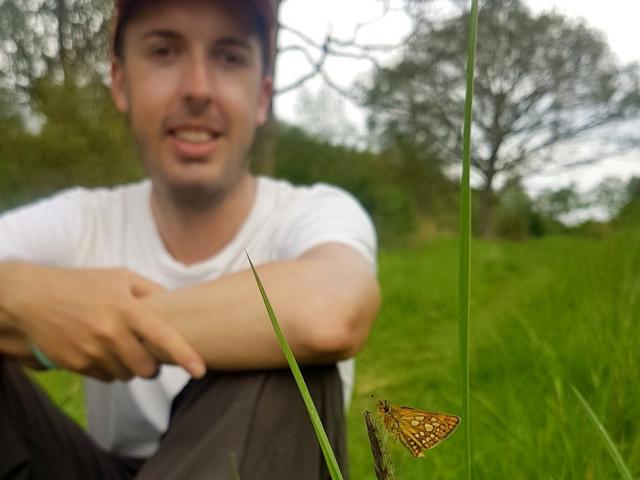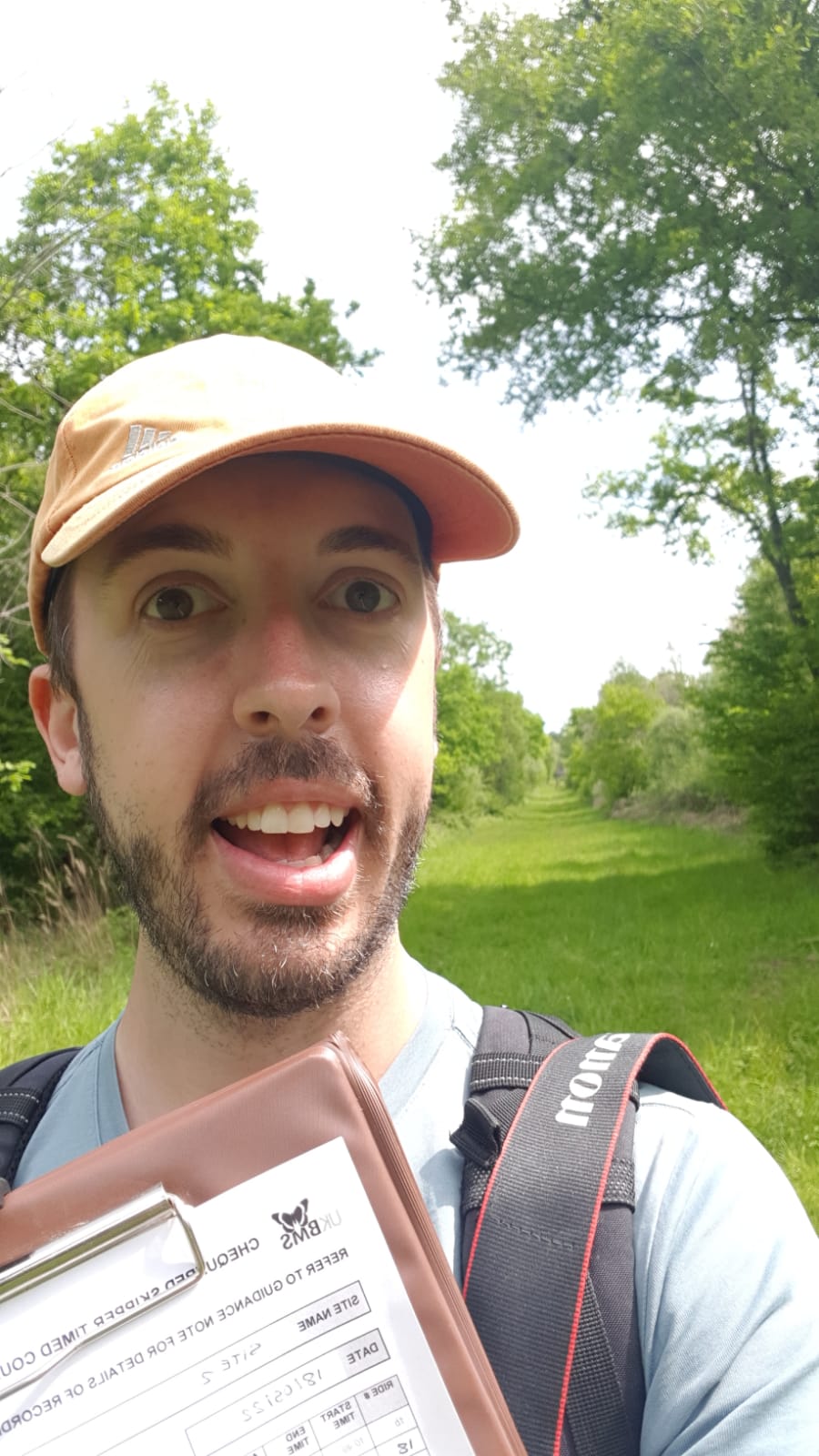PhD Candidate at the University of Northampton, Jamie Wildman, has recently submitted his thesis on the Chequered Skipper. Jamie is a committee member of the Bedford and Northamptonshire Branch of Butterfly Conservation, and Chief Scientist for Butterfly Conservation, Dr Nigel Bourn, was the external supervisor for Jamie’s PhD.
In this interview, Jamie explores the importance of his research, and his journey to getting into conservation.
Please tell us about your research
My research is on the reintroduced Chequered Skipper. How, why, and when it declined in England, and its ecology, as well as how it behaves in the wood it was released in. We’ve collected over 3,500 extra historical records, mostly from museums and private butterfly collections, and we’ve used them to study how the Chequered Skipper was distributed across England. We’ve also developed a really cool photographic way of studying how the butterfly moves around, how far it flies, and how big the population is. We’ve looked at the reintroduction project more generally to see where reintroduction is at globally right now, too.
My external supervisor was Dr Nigel Bourn, Chief Scientist at Butterfly Conservation. Nigel is a specialist in butterfly ecology and taught me how butterflies interact with their habitats, how they deal with their environment, and more about metapopulation science – so, the intricacies of butterfly populations and how they move around landscapes.
Why is this area of research so important?
I think it’s really important to understand how a butterfly species behaves after it’s been reintroduced. I think research like this helps us to answer fundamental, but very important, questions, like whether habitat is suitable, whether colonies are getting bigger or smaller year on year, and what the long-term prospects of a reintroduced species like the Chequered Skipper are. The data that we generate can be used to judge how successful the work of Butterfly Conservation, along with Forestry England, to create wide and sunny rides in woodland, has been for the Chequered Skipper.
Looking at the historical side of things helps us to understand what causes decline in the first place, and hopefully prevent similar pressures on the environment from affecting the Chequered Skipper to the point that we lose them from England all over again. One of my go-to phrases is ‘learning about the past better informs the future of conservation’. That’s something I feel we’ve been able to demonstrate with the Chequered Skipper.
What led you to be interested in this area?
I find history really fascinating generally, but especially in the context of the butterfly, where you have to act like a criminal investigator of sorts, and pull loads of puzzle pieces together from different sources like museums and entomological diaries – they’ve been a really fascinating source of data – and even anecdotal evidence from people who were around when the butterfly was still on the wing in England, to essentially explain how an entire species met its demise. You can’t go looking for bones like a zooarchaeologist would – you have to look for different sources of information.
Shadowing a reintroduction is so interesting because you’re getting to see how something as fragile as a butterfly is transported from one part of the world to the other. It’s a huge privilege and something very special to be a part of. As is being able to walk around gorgeous woodland day after day looking for the butterflies and seeing how they are behaving in their new habitat. The experienced butterfly recorders we had monitoring for the species were taking loads of photographs. Looking at those photographs, we realised that each Chequered Skippers’ wing markings were unique. So, we ended up using the photos to see where the butterfly was going, how far it could fly, and things like that.
To go back to the start of the project, the very start, I think it was November 2016 when I volunteered at a Wildlife Trust work party and started talking to a chap called Dr Robin Field – who was involved, it turned out, in the very early stages of the reintroduction – about getting involved in conservation work. He told me about the Chequered Skipper project that was in the works, but nothing was confirmed or official then. It kind of all kicked off from there, really, so I owe a lot to him.
What might you like to do in the future?
I’d love to work in conservation, obviously, as that’s what my entire research project has revolved around. Whether that be post-doc on the Chequered Skipper or another butterfly species, working on species reintroduction or even investigating the possibility of one. Studying how butterflies move around habitat is an interesting topic because my research has taught me that habitats are now so much more fragmented than they used to be in England, and so I think it’s really important to ascertain exactly how connected the woodland that we have in England is now and what we can potentially do to improve it.
I’m open to moving into different fields of ecology too, maybe oceanography, and looking at marine biology, perhaps. But there’s no rush, I’ve still got my PhD viva to pass yet!

What are your favourite butterflies and moths?
I’m a bit of a romantic, so I think the really big, dark ones that have a kind of gothic brooding vibe about them... I’ve always loved the Camberwell Beauty. I’ve always been drawn to that, probably because one of its alternative names is ‘mourning cloak’. I find that really poetic and romantic.
I also really love the White Admiral. They’ve just got a very dark, gloomy, brooding vibe about them. Thinking about moths, I’ve always liked the Buff-Tip because I am super impressed by how well they impersonate silver birch twigs. I’m also a big fan of Mint Moths. I love species that can indicate something – that something else is around – which for the mint moth is mint! They’re really very pretty to look at even though they’re tiny. They’re magnificently coloured, so they’re probably my other favourites…other than the Chequered Skipper obviously! I don’t think I’ve ever seen a butterfly with as much personality as a Chequered Skipper, but I’m probably just biased!
Why are butterflies so special to you?
This is more sentimental and heartfelt for me. I do have a sentimental connection to butterflies because they symbolise a turning point in my life in a lot of ways. I remember I was growing really disillusioned with the career path I was on at the time; I was taking a master’s degree in English at UCL (University College London), and I was supposed to be writing my dissertation, but I had this huge writer’s block. I remember walking to a village called Barton Seagrave, not too far from my house. I’ll never forget that I was totally captivated by this huge Buddleia. I remember looking up and it felt like it was dozens of meters tall, and it was absolutely covered in butterflies – Peacock, Small Tortoiseshell, Small White, all sorts of things. The butterflies just had such innocence and such joy about them, and it was enigmatic of the whole summer, I guess – the sun, the heat, and the buzz of summertime. It’s about what they represent for me and what they symbolise. I think if it wasn’t for that walk and the Buddleia… I don’t think I’d be where I am now if I’m honest. So that probably was the start of it all, back in 2013.
Within half an hour of starting my volunteer work with Robin Field and the Wildlife Trust in 2016, beating down brambles that were overgrown in a water meadow, I asked Robin – who was leading the work party – how I might go about getting into conservation, and it just so happened, in the most serendipitous way, that this Chequered Skipper project was coming up. That started this whole new phase of my life that’s essentially determined my future, because I’ve found something I’m incredibly passionate about that I want to stick with for the rest of my life.
Is there anything you’d like to add?
I’d like to add my absolute heartfelt thanks to Butterfly Conservation for the opportunity and to the University of Northampton as well. Without them supporting me in the way they have done I wouldn’t have been able to jump into this absolutely incredible research project, so it’s all thanks to them.


